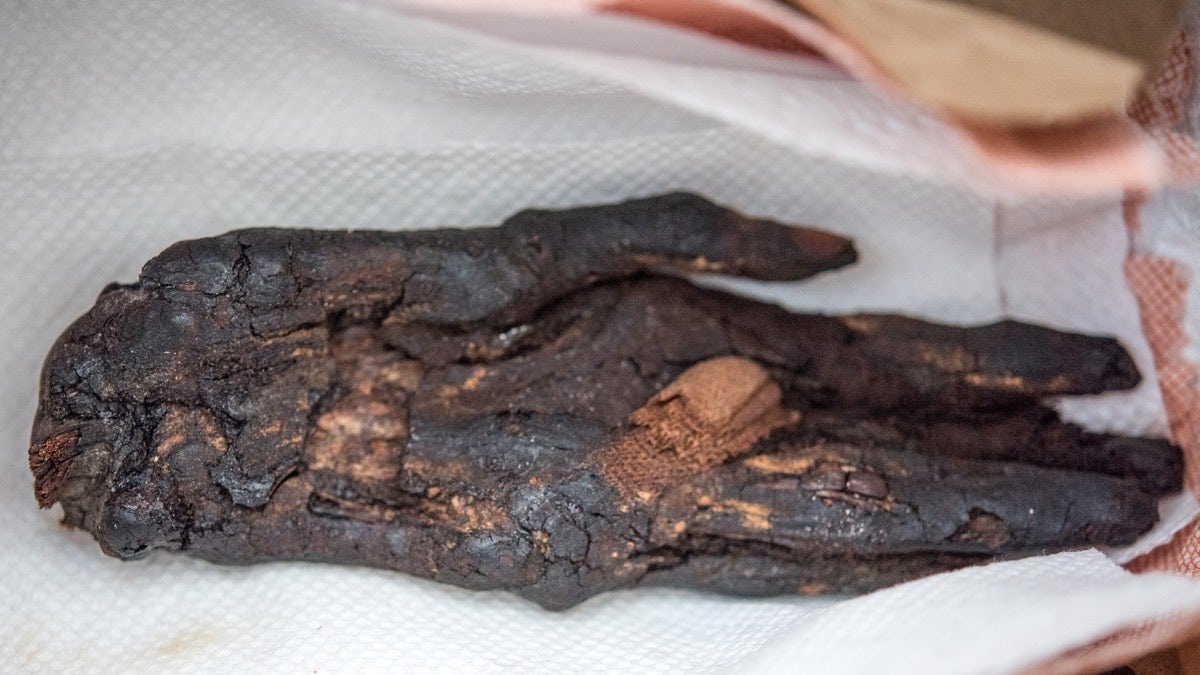
This mummy hand, from the eighth century B.C., had been smuggled into the United States from Egypt. (Josh Denmark/ICE)
The blackened, cloth-wrapped hand arrived in a parcel at Los Angeles International Airport in January 2013. It was listed as a sci-fi movie prop, valued at $66. But as officials with U.S. Customs and Border Protection learned, the hand was from a real Egyptian mummy, nearly 3,000 years old.
The hand was apparently voluntarily forfeited by the importer, and U.S. authorities have repatriated it and four other illegally smuggled artifacts to Egypt as part of an ongoing investigation known as "Operation Mummy's Curse."
"It's sort of amazing the things people will try and ship across international borders," archaeologist Fredrik Hiebert, a National Geographic fellow, said in a video statement. [See Photos of the Mummy Hand and Other Artifacts Returned to Egypt]
In addition to the eighth-century-B.C. mummy hand, U.S. Immigration and Customs Enforcement, or ICE, also returned intricately painted ancient sarcophagi in a ceremony at the Egyptian embassy in Washington, D.C., on Dec. 1.
More From LiveScience
"While we recognize that cultural property, art and antiquities are assigned a dollar value in the marketplace, the cultural and symbolic worth of these Egyptian treasures far surpasses any monetary value to the people of Egypt," ICE Director Sarah Saldaña said during her remarks.
ICE launched "Operation Mummy's Curse" in 2009 to bust a network of antiquities smugglers bringing illicit artifacts from other countries into the United States. Saldaña said her agency has made four arrests and two convictions in this investigation.
The operation has also recovered about 7,000 artifacts, not just from Egypt, but also from Greece, India and Iraq. ICE has already returned many of those cultural objects in past repatriation ceremonies. In March 2015, for example, ICE returned artifacts to Iraqi officials , including an ancient Sumerian ax that was being sold on Craigslist in 2012 as well as a gold-plated soap dish from Saddam Hussein's palace that turned up in Connecticut. In April 2015, ICE handed over dozens of other artifacts to Egypt, including a nesting sarcophagus the agency recovered from a garage in Brooklyn, New York.
Though international treaties and Egyptian laws protect Egyptian artifacts, a black market for antiquities thrives. Using satellite data, researchers have documented an uptick in illegal excavations across archaeological sites in Egypt over the last decade.
Smugglers using forged papers can bring looted material into the U.S. under the guise of a robust legal antiquities market. Census Bureau documents show that about $26 million worth of artifacts were exported from Egypt to the United States just during the first five months of 2016. But that could change. U.S. Secretary of State John Kerry signed an agreement with Egypt on Nov. 29 that imposes tougher import restrictions on Egyptian archaeological material that dates from 5200 B.C. to A.D. 1517.
Original article on Live Science.




















